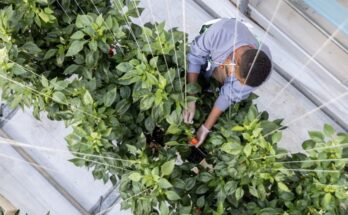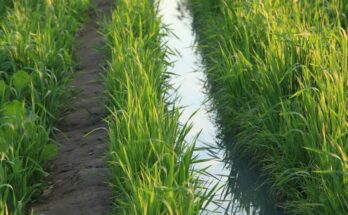Natural farming has suddenly become a catchphrase among researchers and policymakers as well as drawn the Government’s attention. Natural (nature) farming is practicing agriculture following the laws of nature by taking into cognizance the balance of natural biodiversity around the farm to ensure the least disturbance to agroecology. Historically, after shifting from nomadic hunting food gatherer lifestyle to secondary food producer, humans produced a variety of agricultural products and started to use all natural materials around them for enhanced farm productivity.
From around 1 billion in 1800, the population touched 2 billion level in 1930 and then surged to 8 billion by 2020 demanding higher agricultural production. Chemical agriculture started only with the industrial revolution in the early 20th Century for enhanced farm productivity and nitrogen fertiliser formed the crucial component of crop production. India launched ‘Green Revolution’ by introducing fertiliser and water-responsive varieties and thereby transformed from a ‘begging bowl’ to ‘food self-reliant nation’. The Global Hunger Index in 2021 decreased by 30 per cent but still India is at 101st position out of 116 countries.

Despite a plateau, in the quest of reaping higher yields, farmers started indiscriminate use of inorganic fertilisers and pesticides contaminating the food chain. It further disturbed the delicate ecological balance polluting the soil, water and air. The pesticide sprays destroyed the natural biodiversity of beneficial organisms such as honeybees, pollinators among other organisms. Like in other systems, misuses and abuses have inflicted damage to agriculture also, especially the soil microbial health.
‘The One-Straw Revolution’ by Masanobu Fukuoka reemphasised natural farming with minimum human interference and letting the natural processes to maximise crop outputs. While it is not abandonment of farming but to gradually taking it back to nature with reduced human interference over years. Government of India also introduced Paramparagat Krishi Vikas Yojana (PKVY) to promote organic farming and in 2020-2021 introduced sub-scheme Bhatariya Prakritik Krishi Padhati (BPKP) to promote traditional indigenous practices. Following the Union Budget 2022, Indian Council of Agricultural Research (ICAR) has constituted a committee to develop the syllabus for formal natural farming education. Taking a cue from Subhash Palekar, Andhra Pradesh, Karnataka and Maharashtra promoted Zero Budget Natural Farming (ZBNF) which promotes the use of homemade recipes of organic manures and pesticides as well as soil moisture conservation practices. Interestingly all these organic inputs are also used in organic farming, but in watershed due to the non-availability of quality organic manures.
You may also like to read: 5 Govt schemes, promoting organic farming in India
Definitely, human and animal health, as well as conservation of natural resources for posterity, are of paramount importance. So, it may be easier to make the current stabilised agricultural systems sustainable with some mid-course corrections. These include reduction in indiscriminate use of fertilisers and pesticides, promotion of alternate green inputs for enhanced crop production, promotion of agro-ecological agricultural systems, and conservation of natural resources.
A study published in Lancet in 2020 projects population of India by 2048 to be 1.6 billion which will require about 332 million tonnes of food grains. A meta-analysis in Nature 2021, suggests global food demand to increase by 35-56 per cent with increased hunger risk. On the other side, ICAR-National Academy of Agricultural Research Management (NAARM) reported that natural farming reduced available nutrients in the produce, variable soil microbial populations, reduction in yields except in finger millet, and stressed for institutional arrangements for marketing. However, as many farmers are practicing for last 15 years or so, a systematic long-term scientific study is required to understand these dynamics under different agro-climates, soil systems and cropping systems which was also endorsed at the BioAg Asia 2022.
You may also like to read: VP Naidu draws attention to soil health and organic farming for sustainable food production
Further, it was felt that under inelastic arable land scenario, even after using permitted external inputs, organic agriculture yielded less by about 20 per cent. At current lower productivity levels in many crops, even if yields recover after 4-5 years, how to compensate the farmer for reduced yields is a question. And, assured premium prices on a sustainable basis is also a debatable issue. In this backdrop, to attain the entailed goals of natural farming the following issues need to be addressed
- Contextualising the traditional farming practices to contemporary modern production systems of the crops, varieties and crop husbandry with supporting data to avoid disruption in the food supply chain.
- Forecasting the per capita foodgrain availability scenario under both current agricultural systems vis-à-vis natural farming systems, and projected timelines for achieving the natural farming outcomes using robust modelling tools before the transition is initiated.
- Developing SOPs for natural farming to harmonise the systems across agro-ecologies to ensure reproducibility, traceability and safety.
- The possibility to develop hybrid models promoting sustainable farming systems vis-à-vis safe and nutritious produce.
- A roadmap to meet the huge quantities of organic fertilisers and quality bio-inputs as the animal component is dwindling in agriculture.
- Wherewithal for setting up a robust extension system for smooth transfer of technology.
- While most advocate for a premium price, already some entrepreneurs are marching forward offering organic produce at normal prices. A critical analysis of such models would be worth it.
Hence, natural farming could be initiated for niche crops in niche agroecologies through long-term trials for understanding its impacts. Simultaneously efforts should be made to educate people about the misuse and abuse of agrochemicals. Natural farming is knowledge-intensive and needs an extensive extension network which is most wanting as on today.
(Dr. Suseelendra Desai is the Dean of NMIMS School of Agricultural Sciences &Technology. Views expressed in the article are author’s own.)





Hi, just wanted to mention, I loved this blog post. It was inspiring. Keep on posting!